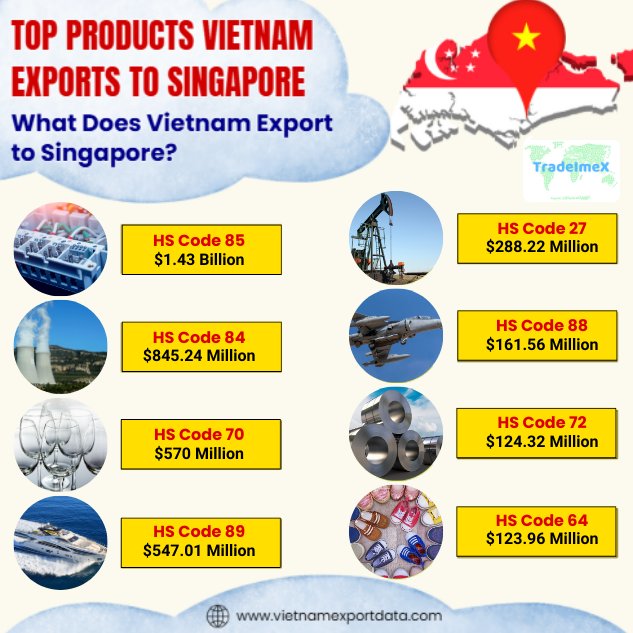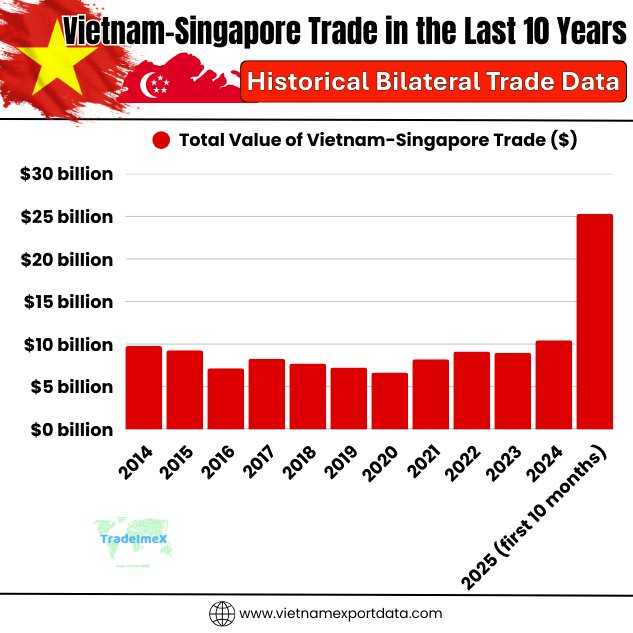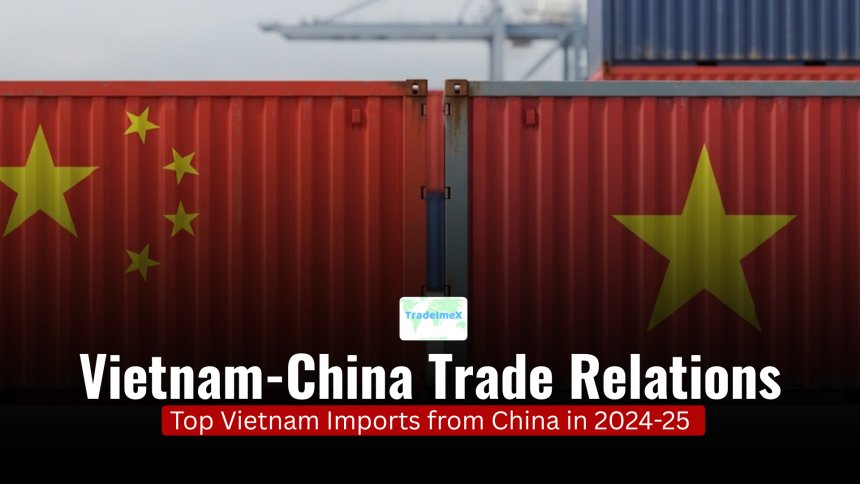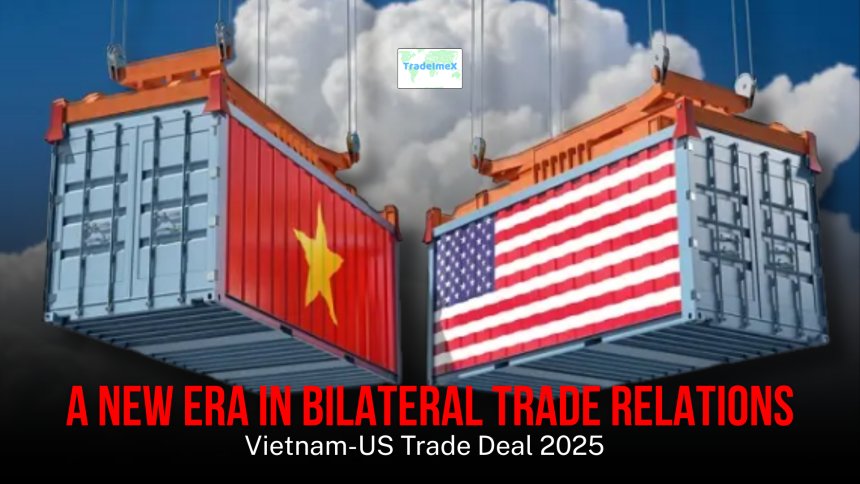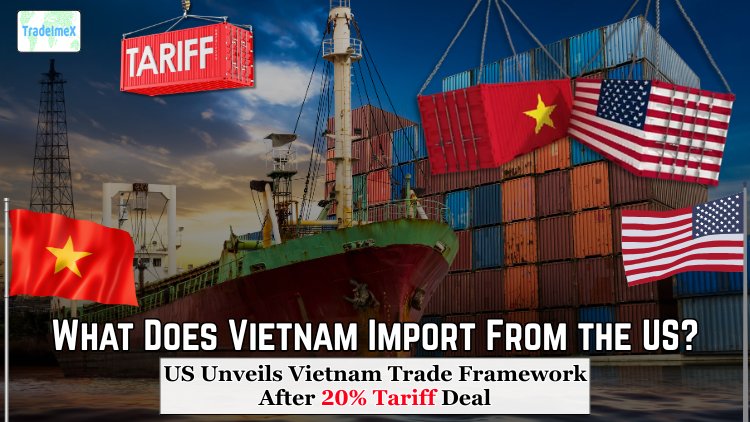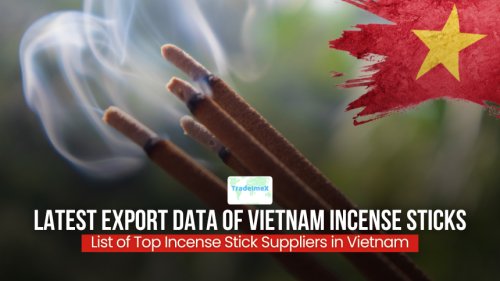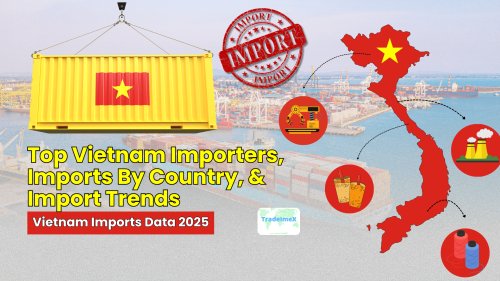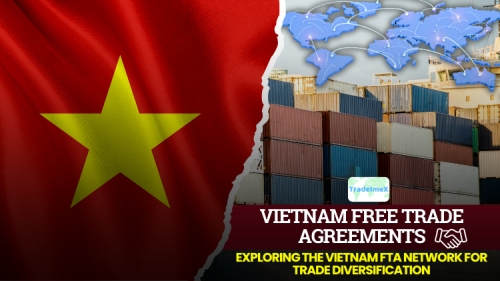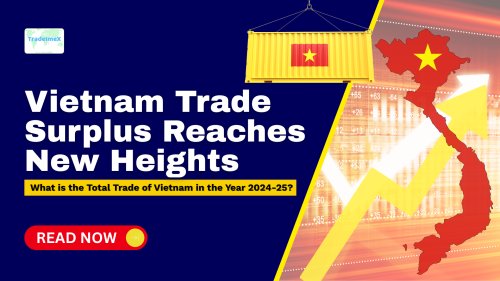Vietnam-Singapore Trade Value Hits $25.3 Billion in 2025: Record High Bilateral Trade
Vietnam–Singapore trade value hit a record US$25.3 billion in 2025, marking a 26.7% year-on-year surge. Explore key drivers, top imports & exports, historical trade data, and what this growth means for both economies.
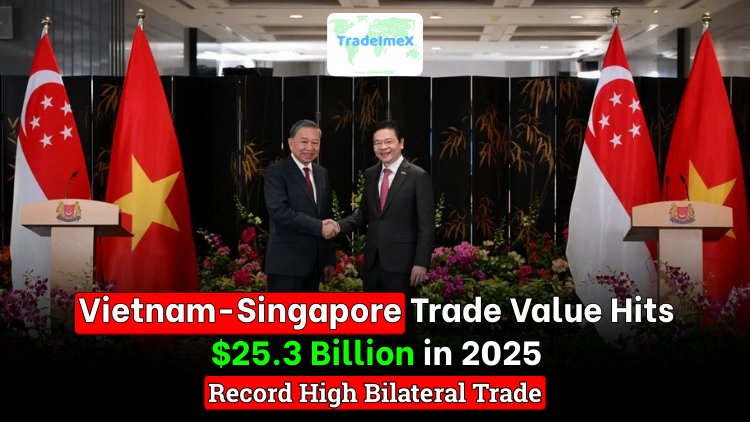
In 2025, bilateral trade between Vietnam and Singapore reached a historic high: in the first ten months, their total trade exceeded S$33 billion, equivalent to approximately US$25.3 billion. This marks a 26.7% year-on-year rise compared to the same period in 2024 and has already eclipsed the full-year 2024 trade volume, which had stood at S$31.67 billion.
According to the latest Vietnam import data and Singapore export data, the total value of Vietnam imports from Singapore reached $5.32 billion in 2024, a 3% increase from the previous year. According to the Vietnam export data, the total value of Vietnam exports to Singapore reached $5.14 billion in 2024. The Vietnam-Singapore bilateral trade reached $10.46 billion in 2024. The total Vietnam-Singapore trade value accounted for $25.3 billion in the first 10 months of 2025, as per the Vietnam customs data.
Vietnam is the 10th largest trading partner of Singapore, according to global trade data. This blow-out growth underscores the strength and deepening nature of economic ties between Vietnam and Singapore. It also signals broader shifts in the regional economic landscape: more integrated supply chains, growing intra-ASEAN trade, and a rising emphasis on high-value manufacturing.
The Trade Numbers: What Exactly Is Behind This Surge
Trade Volume & Growth Dynamics
-
Over the first ten months of 2025, total bilateral trading value (goods) between the two nations reached S$33 billion, about US$25.3 billion, marking a record high in Vietnam-Singapore trade.
-
Singapore's exports to Vietnam grew to S$22.7 billion, a 19.4% increase versus the same period in the prior year.
-
Imports into Singapore from Vietnam surged even more dramatically, reaching S$10.4 billion, up 46.4% year-on-year.
-
In October 2025 alone, monthly bilateral trade hit S$3.9 billion, a 36.8% jump compared to October 2024. Singapore exported S$2.2 billion worth of goods to Vietnam that month, and its imports from Vietnam were S$1.7 billion, more than doubling (109.3%) relative to October 2024.
These figures suggest not just steady growth, but accelerated momentum, particularly from Vietnam’s side.
Trade Balance & Origin-Based Surplus
-
When you look at only goods originating in Vietnam and Singapore (i.e., not counting re-exports via Singapore), Vietnam achieved a trade surplus of around S$4.22 billion in that 10-month window.
-
This means that a significant portion of trade isn’t just transit of third-country goods; Vietnam is exporting its own manufactured goods to Singapore in big volumes.
Partner Status
-
With this surge, Vietnam continues to hold the position of Singapore’s 10th largest trading partner (in terms of goods trade), underscoring its growing importance in Singapore’s trade network.
-
On Singapore’s side, a large share of exports to Vietnam are re-exports, goods that pass through Singapore but originate elsewhere.
Top Goods Vietnam Imports from Singapore: What Does Vietnam Import from Singapore?
Vietnam imports a diverse range of goods from Singapore, with electronic components being one of the top items. Machinery and equipment are also significant imports, showcasing Vietnam's strong focus on industrial development. Chemical products, particularly petroleum and related products, play a critical role in supporting Vietnam's energy needs. These imports highlight the strategic partnership between Vietnam and Singapore, emphasizing mutual economic benefits and cooperation. The top 10 products that Vietnam imports from Singapore, as per the Vietnam customs import statistics & Vietnam imports by country for 2024-25, include:
1. Mineral fuels & oils (HS code 27): $2.61 billion
Mineral fuels and oils are among the top imports from Singapore to Vietnam, with a total value of $2.61 billion. Singapore is known for its petroleum refining industry, making it a major exporter of mineral fuels and oils to Vietnam.
2. Electrical machinery & equipment (HS code 85): $492.02 million
Electrical machinery and equipment are also high on the list of imports from Singapore to Vietnam, with a total value of $492.02 million, as per the customs data on Vietnam electronics imports from Singapore by HS code. Singapore is known for its high-quality electronics manufacturing sector, which contributes to the significant import of electrical machinery and equipment by Vietnam.
3. Essential oils, perfumery, & cosmetics (HS code 33): $410.58 million
Vietnam imports essential oils, perfumery, and cosmetics worth $410.58 million from Singapore. Singapore is a hub for the beauty and wellness industry, making it a top supplier of these products to Vietnam.
4. Plastics & articles thereof (HS code 39): $335.97 million
Plastics and articles thereof are also among the top imports from Singapore to Vietnam, with a total value of $335.97 million. Singapore's well-established plastics industry makes it a key supplier of plastic products to Vietnam.
5. Miscellaneous edible preparations (HS code 21): $314.55 million
Vietnam imports miscellaneous edible preparations worth $314.55 million from Singapore. These include a variety of food products and additives that are in demand in the Vietnamese market.
6. Organic chemicals (HS code 29): $276.54 million
Singapore is a significant supplier of organic chemicals to Vietnam, with imports totaling $276.54 million. These chemicals are used in various industries, including pharmaceuticals, agriculture, and manufacturing.
7. Miscellaneous chemical products (HS code 38): $194.39 million
Vietnam imports miscellaneous chemical products worth $194.39 million from Singapore. These products include a wide range of chemical compounds used in different industries.
8. Nuclear reactors & machinery (HS code 84): $188.54 million
Nuclear reactors and machinery are also among the top goods imported by Vietnam from Singapore, with a total value of $188.54 million. Singapore's expertise in high-tech machinery and equipment makes it a key supplier to Vietnam in this category.
9. Optical, medical, surgical instruments (HS code 90): $86.79 million
Singapore is a major supplier of optical, medical, and surgical instruments to Vietnam, with imports totaling $86.79 million. These high-quality instruments are essential for Vietnam's healthcare and medical sectors.
10. Preparations of cereals & pastrycook products (HS code 19): $62.82 million
Vietnam imports preparations of cereals and pastrycook products worth $62.82 million from Singapore. These include a variety of processed food products that cater to the Vietnamese market's diverse culinary preferences.
Top Products Vietnam Exports to Singapore: What Does Vietnam Export to Singapore?
Vietnam is a significant player in the world of exports to Singapore, showcasing a diverse array of top products that have solidified its trade relationship with the Lion City. Among the top products Vietnam exports to Singapore are electronics, garments, machinery, seafood, and agricultural produce. This export mix not only showcases Vietnam's manufacturing skill but also its agricultural bounty. The top 10 goods that Vietnam exports to Singapore, as per the Vietnam-Singapore trade data and Vietnam shipment data for 2024-25, include:
1. Electrical Machinery & Equipment (HS Code 85): $1.43 Billion
Electrical machinery and equipment are among the top products that Vietnam exports to Singapore. With a total value of $1.43 billion, this category includes items such as electrical circuits, transformers, and electrical capacitors. These products are essential for Singapore's industrial sector, powering various industries and contributing to the country's overall economic growth.
2. Nuclear Reactors & Machinery (HS Code 84): $845.24 Million
Nuclear reactors and machinery are another key export category for Vietnam, with a total value of $845.24 million. This includes reactors, boilers, and machinery used in the energy sector. These products play a crucial role in Singapore's energy infrastructure, supporting the country's power generation capabilities.
3. Glass & Glassware (HS Code 70): $570 Million
Vietnam also exports glass and glassware to Singapore, with a total value of $570 million, as per the customs data on Vietnam glass exports to Singapore by HS code. This category includes products such as glass containers, mirrors, and laboratory glassware. These items are essential for various industries in Singapore, including construction, manufacturing, and healthcare.
4. Ships, Boats, & Floating Structures (HS Code 89): $547.01 Million
Ships, boats, and floating structures are significant exports from Vietnam to Singapore, with a total value of $547.01 million. These products are crucial for Singapore's maritime industry, supporting transportation, trade, and tourism activities in the region.
5. Mineral Fuels & Oils (HS Code 27): $288.22 Million
Vietnam also exports mineral fuels and oils to Singapore, with a total value of $288.22 million. This category includes products such as petroleum oils, natural gas, and coal. These resources are essential for Singapore's energy needs, powering various sectors of the economy.
6. Aircraft, Spacecraft, & Parts Thereof (HS Code 88): $161.56 Million
Aircraft, spacecraft, and parts thereof are another significant export category for Vietnam, with a total value of $161.56 million. These products include aircraft engines, parts, and components. They are crucial for Singapore's aviation industry, supporting air travel and cargo transportation.
7. Iron & Steel (HS Code 72): $124.32 Million
Vietnam exports iron and steel products to Singapore, with a total value of $124.32 million, as per the data on Vietnam steel exports to Singapore. This category includes items such as iron bars, rods, and steel structures. These materials are essential for Singapore's construction and manufacturing sectors, driving infrastructure development in the country.
8. Footwear (HS Code 64): $123.96 Million
Footwear is another key export product from Vietnam to Singapore, with a total value of $123.96 million. This category includes shoes, boots, and sandals. Vietnamese footwear is popular in the Singaporean market, catering to consumer demand for quality and style.
9. Cereals (HS Code 10): $104.20 Million
Vietnam exports cereals to Singapore, with a total value of $104.20 million. This category includes products such as rice, wheat, and corn. These staple foods are essential for Singapore's food security and consumption needs.
10. Salt, Sulfur, Lime, & Cement (HS Code 25): $97.16 Million
Lastly, Vietnam exports salt, sulfur, lime, and cement to Singapore, with a total value of $97.16 million. These products are crucial for Singapore's construction and infrastructure projects, supporting development and growth in the country.
Vietnam-Singapore Trade in the Last 10 Years: Historical Bilateral Trade Data
|
Year of Trade |
Total Value of Vietnam-Singapore Trade ($) |
|
2014 |
$9.77 billion |
|
2015 |
$9.28 billion |
|
2016 |
$7.17 billion |
|
2017 |
$8.28 billion |
|
2018 |
$7.71 billion |
|
2019 |
$7.24 billion |
|
2020 |
$6.65 billion |
|
2021 |
$8.23 billion |
|
2022 |
$9.13 billion |
|
2023 |
$8.99 billion |
|
2024 |
$10.46 billion |
|
2025 (first 10 months) |
$25.3 billion |
What Is Powering This Trade Explosion? Key Drivers
To understand why Vietnam–Singapore trade is booming, it’s essential to examine several key structural and short-term drivers.
1. Deepening Supply-Chain Integration
-
A major driver is intra-industry trade in high-value sectors: both nations are trading complex intermediate goods like machinery, electronic components, and mechanical parts, rather than just raw materials.
-
For example, a lot of Singapore’s exports to Vietnam are in electrical machinery and equipment (HS-85), as well as in machinery, reactors, and boilers (HS-84). These are not simple consumer goods; they reflect integrated, high-skill manufacturing links.
2. Strategic Institutional Framework: Comprehensive Strategic Partnership (CSP)
-
Vietnam and Singapore have elevated their relationship to a Comprehensive Strategic Partnership. Through this, they are deepening cooperation across trade, investment, infrastructure, digital economy, and energy.
-
This framework boosts predictability and trust for businesses: with institutional backing, companies feel more confident to invest in joint projects, build regional value chains, and expand trade.
3. Trade Diversification & Resilience
-
With global trade volatility rising, both countries are reinforcing regional linkages. For Vietnam, it’s part of a broader “China +1” strategy, where manufacturers diversify manufacturing bases to Southeast Asia.
-
Singapore, meanwhile, continues to leverage its role as a regional hub, not just for final goods, but for distributing and transiting goods across ASEAN and beyond.
4. Re-Exports Through Singapore
-
A very large portion of Vietnam’s imports from Singapore are, in fact, re-exports. Many goods imported into Vietnam via Singapore are not made in Singapore: they are third-country goods that use Singapore as a trade hub.
-
This role of Singapore amplifies its importance as a distribution and trade node, even if not all value originates from it.
5. Scale-Up in Specific Product Categories
-
On Singapore’s export side, electrical machinery, fuels and petroleum products, and machinery (reactors, boilers, mechanical appliances) dominate. These two (HS-85 and HS-27) alone account for more than two-thirds of Singapore’s export value to Vietnam.
-
On Vietnam’s export side to Singapore: the fastest-growing categories include electrical machinery, machinery/boilers, glass and glassware, and precision instruments (optical, medical, measuring).
-
Other interesting categories: seafood, beverages, and even more niche precision goods are expanding in Vietnam’s export mix to Singapore.
6. Strengthening Investment Flows
-
Singapore remains a top investor in Vietnam. Through the CSP and related mechanisms, Singaporean capital is flowing into manufacturing, infrastructure, green energy, and technology in Vietnam.
-
This investment not only fuels production in Vietnam but also embeds Singapore more firmly into Vietnam’s economic ecosystem.
Strategic Implications: Why This Matters for Both Countries
For Vietnam
-
Upgrading Its Industrial Base: The shift toward machinery, electronics, and precision goods implies Vietnam is not just competing on cheap labor. Its manufacturing is moving up the value chain.
-
Building Export Resilience: By diversifying trade via Singapore, Vietnam lowers its exposure to traditional export markets and builds more robust regional channels.
-
Gaining Foreign Investment: Singapore’s capital, especially for key sectors such as infrastructure, green energy, and industry, could be a powerful lever for Vietnam’s development.
-
Improving Its Trade Balance: The surplus in originating goods strengthens Vietnam’s trade account and gives it more leverage in future negotiations.
For Singapore
-
Reinforcing Its Role as a Regional Hub: Singapore’s strength as a trading and re-export center is reaffirmed. It is not just a hub for Southeast Asia, but a crucial node for high-value goods.
-
Exporting High-Value Goods: By exporting sophisticated machinery and electrical equipment, Singapore is not just serving as a pass-through; it’s supplying advanced industrial goods.
-
Strategic Investment Partner: Singapore’s investments benefit from the CSP framework and give it influence and stakes in Vietnam’s future sectors, like infrastructure and clean energy.
-
Risk Diversification: Deepening ties with Vietnam helps Singapore reduce exposure to more volatile trade relationships elsewhere, and strengthens intra-ASEAN-Vietnam trade integration.
For the Region and Beyond
-
ASEAN Integration Deepens: This strengthens the footprint of intra-ASEAN trade and enhances the economic cohesion of the region.
-
Supply-Chain Resilience: As companies look to de-risk global supply chains, the Vietnam–Singapore link becomes a model for flexible, diversified production.
-
Strategic Leverage: In a world of geopolitical and economic uncertainty, both Vietnam and Singapore gain strategic economic leverage by deepening mutual dependence.
Risks, Challenges & Points to Watch
Even as this trade boom is impressive, there are several risks and structural challenges that could complicate the path ahead:
-
Heavy Dependence on Re-Exports
-
A large chunk of Vietnam’s imports from Singapore are re-exports, not Singapore-made goods. If global trade routes shift or if re-export flows change, the trade volume could be impacted.
-
This reliance dilutes the purely bilateral economic value: it's not always Vietnam-Singapore value-add, but third-party goods moving through Singapore’s hub.
-
Concentration Risk in Key Sectors
-
While electrical machinery and fuels are dominant, over-reliance on a few categories can be risky. For example, a downturn in global demand for electronics or energy could disproportionately hit this trade link.
-
Vietnam, especially, may become vulnerable if its export growth to Singapore remains concentrated in just a few product lines.
-
Intense Regional Competition
-
Other ASEAN countries are also vying for Singaporean investment and trade. Vietnam must continuously improve its infrastructure, regulatory environment, and labor skills to stay competitive.
-
Competition from Malaysia, Indonesia, and Thailand for manufacturing and export investment could intensify.
-
Global Trade Uncertainty
-
Protectionist pressures, shifting tariff regimes, or geopolitical tensions can disrupt trade flows.
-
There's a risk that external shocks (e.g., macroeconomic downturns in major markets) affect both countries’ trade dynamics.
-
Sustainability & ESG (Environmental, Social, Governance)
-
Rapid trade growth needs to be aligned with sustainability goals. Manufacturing, particularly in electronics and machinery, can be resource-intensive.
-
Labor standards, environmental regulations, and compliance with ESG norms will become more important as trade grows.
-
Infrastructure and Trade Bottlenecks
-
As trade increases, both countries will need to invest in customs efficiency, port capacity, and trade facilitation.
-
Delays, inefficiencies, or regulatory hurdles could erode the benefits of this trade growth over time.
What Lies Ahead: Future Scenarios and Opportunities
Given the current momentum and the structural backdrop, here’s what the future might hold for the Vietnam–Singapore trade relationship, and where the biggest opportunities lie:
1. Deepening Through the CSP
-
The Comprehensive Strategic Partnership can be a foundational platform. Joint infrastructure projects, clean energy (solar, green hydrogen), smart industrial parks, and high-tech manufacturing zones could all be pursued under its banner.
-
Both countries could set up joint investment funds or platforms to co-invest in Vietnamese infrastructure, technology startups, or green projects.
2. Moving Up the Value Chain
-
Vietnam could become a more important node in high-value electronics and machinery production. As its industrial capabilities improve, it may produce more advanced components that integrate into Singapore-led supply chains.
-
There is strong potential in green technologies. Singapore has capital and technological expertise, and Vietnam has demand and resource potential. Collaborations in renewable energy, smart grids, and energy storage make sense.
-
The medical and precision instruments sector (optical, measuring, medical devices) is already growing in Vietnam’s export mix to Singapore; this could be a high-growth niche.
3. Trade Facilitation & Digitalization
-
To support such high trade volumes, both nations will benefit from more efficient customs processes, digital trade platforms, and improved data sharing.
-
Investments into e-customs, digital trade corridors, and customs automation could reduce transaction costs and speed up goods flow.
4. Services & Investment Integration
-
While goods trade is booming, the next frontier is services trade: financial services, logistics, professional services, and digital services could all be expanded under bilateral cooperation.
-
Singaporean firms could increasingly invest in Vietnamese tech startups, fintech, and digital infrastructure via the CSP.
-
Joint funds or investment vehicles may be established to channel capital into priority sectors.
5. Risk Management & Resilience Building
-
Both countries should build mechanisms to distribute risk: whether via trade finance tools, insurance, or supply-chain risk sharing.
-
They should also aim to align on sustainability and ESG frameworks so that trade growth contributes to inclusive, green development.
-
Diversifying export categories and reducing overconcentration will help make the trade more shock-resilient.
Conclusion and Final Thoughts
The surge of Vietnam–Singapore bilateral trade to S$33 billion (US$25.3 billion) in the first ten months of 2025 is not just a temporary spike; it reflects deep structural shifts in how both countries do business. Vietnam is accelerating its transformation into a high-value manufacturing hub, while Singapore is reinforcing its role as a regional trade and investment center.
Key drivers include strong growth in electronics and machinery trade, supply-chain integration, re-export dynamics, and a solid institutional foundation through the Comprehensive Strategic Partnership. But risks remain: dependence on re-exports, concentration in a few sectors, regional competition, and global trade volatility.
Looking ahead, this moment could be the foundation for a deeper, more strategic, and sustainable economic partnership. By fostering joint investments, upgrading industries, & building more resilient trade infrastructure, Vietnam and Singapore have the potential to shape a future trade relation that’s not just bigger, but smarter & more sustainable. If they navigate it correctly, their economic link could become a blueprint for high-value, technologically advanced, and regionally integrated growth in ASEAN in the years to come.
We hope that you liked our insightful & data-driven blog report on the historic Vietnam-Singapore trade value in 2025. For more information on the latest Vietnam trade data, or to search live Vietnam import-export data by country, product, or HS code, visit VietnamExportdata. Contact us at info@tradeimex.in for customized trade reports, market insights, and verified customs databases.
Also read about:
Share
What's Your Reaction?
 Like
0
Like
0
 Dislike
0
Dislike
0
 Love
0
Love
0
 Funny
0
Funny
0
 Angry
0
Angry
0
 Sad
0
Sad
0
 Wow
0
Wow
0


